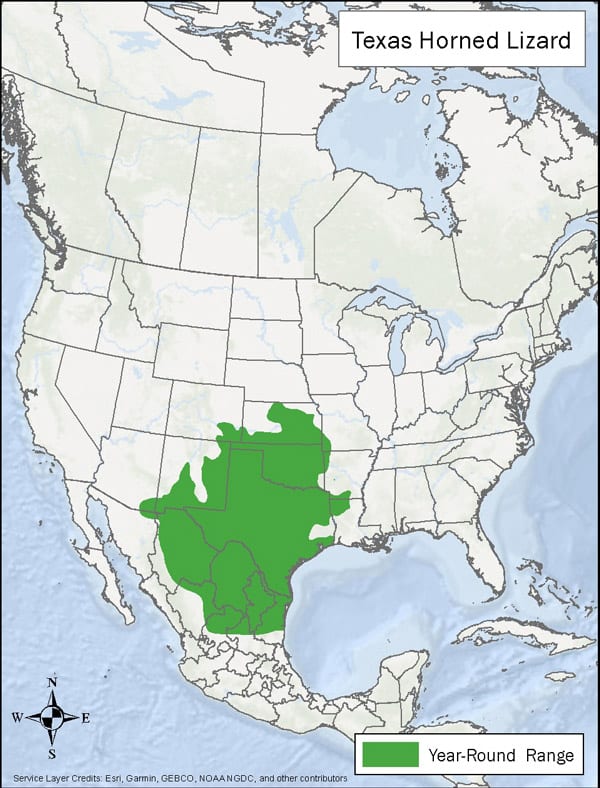LandPKS Learning
Habitat Hub

Texas Horned Lizard
Texas horned lizards feed primarily on harvester ants, 69% of their diet. They wait motionless along harvester ant trails and capture ants as they pass by flicking out their tongue and swallowing whole.
Phrynosoma cornutum
Identification
Texas horned lizards or “horny toads” are small lizards, 2.5-4 in/6.5-10 cm in length, with bodies so flattened that they are almost circular in shape. True to their name, horned lizards also have a row of enlarged scales around their head that resemble horns. Generally brownish or sandy in coloration, horned lizards often have darker spots or mottling that helps them to blend into their environment. These lizards are found in the Southern Great Plains and Chihuahuan Desert from Colorado and Kansas into Northern Mexico.
Observation Tips
Being naturally camouflaged and tending to freeze as a defense mechanism, Texas horned lizards are hard to find. They spend winter underground. When inactive, Texas horned lizards burrow into the ground, use rodent burrows or hide under rocks. During spring and early summer, they can be observed in their habitat by slowly driving paved and unpaved roads in early to late morning. The lizards frequently bask in the sun on roads.
Interesting Fact
Texas horned lizards feed primarily on harvester ants, 69% of their diet. They wait motionless along harvester ant trails and capture ants as they pass by flicking out their tongue and swallowing whole. Horned lizards also have an unusual defense – they squirt blood from their eyes when threatened especially by cats and canids (dogs, foxes and coyotes).
Ideal Habitat
Texas horned lizard live in arid and semiarid areas with open deserts and grasslands, including playa edges, bajadas (alluvial fans), and sand dunes. Areas with 50-80% grass and shrub cover, including yucca and mesquite, provide adequate protection from predators and shade during the heat of the day. Large patches of bare ground, 20-40%, and <20% forbs are ideal for basking and allowing easy movement through the vegetation. Sand and loam soils are preferred with surface cobbles and stones. Texas horned lizards can also be found of black-tailed prairie dog towns. At night, horned lizards bury themselves in soil or take refuge in rodent burrows or similar shelters.

Range map provided by International Union for Conservation of Nature
Management Activities that Benefit Species – Best Management Practices (BMPs)
Maintain and manage for grasslands that contain a diversity of native plant species and a mosaic of habitats with open areas intermixed with more dense cover. Manage fire ant populations where possible. Control feral dogs and cats as horned lizards are an easy meal with no effective defense mechanism. To reduce mortality from vehicles or machinery, new roads should be carefully sited, and care taken when driving roads in morning hours when horned lizards are basking on the road and foraging.
Management Activities to Avoid
Avoid the use of broadcast pesticides to control invasive fire ants. In addition, avoid the use of insecticides in known Texas horned lizard habitat to reduce the impact on harvester ant populations. Avoid collecting Texas horned lizards as pets because they are very hard to care for and tend to die of starvation in captivity.
Other Species that Benefit from Similar Habitat Management
Other species that also benefit from management for Texas horned lizards include greater short-horned lizard, prairie rattlesnake, loggerhead shrike, and ornate box turtle.
Download
Download the Texas Horned Lizard factsheet
Descarga la ficha de lagartija cornuda texana
Other Resources
Hammerson, Geoffrey A. 1999 Amphibians and Reptiles in Colorado. Second Edition. University of Colorado Press.
International Union for Conservation of Nature (IUCN). 2019. The IUCN Red List of Threatened Species. Version 2019-3. Texas horned lizard
NatureServe. 2019. NatureServe Explorer: An online encyclopedia of life [web application]. Version 7.1. NatureServe, Arlington, Virginia. Texas horned lizard
Oklahoma Department of Wildlife Conservation. Field Guide: Texas horned lizard
Photo credit: Patrick Alexander / Flickr
Mobile App | Data Portal | Knowledge Hub | Habitat Hub | Learning Collections | Blog | About | Contact | Support



